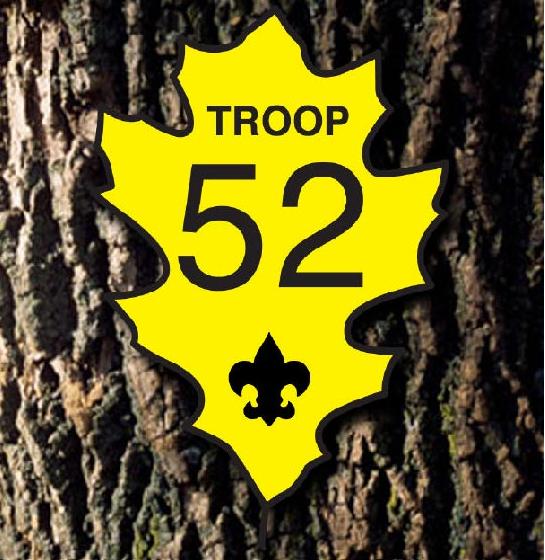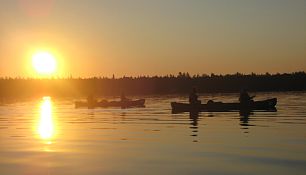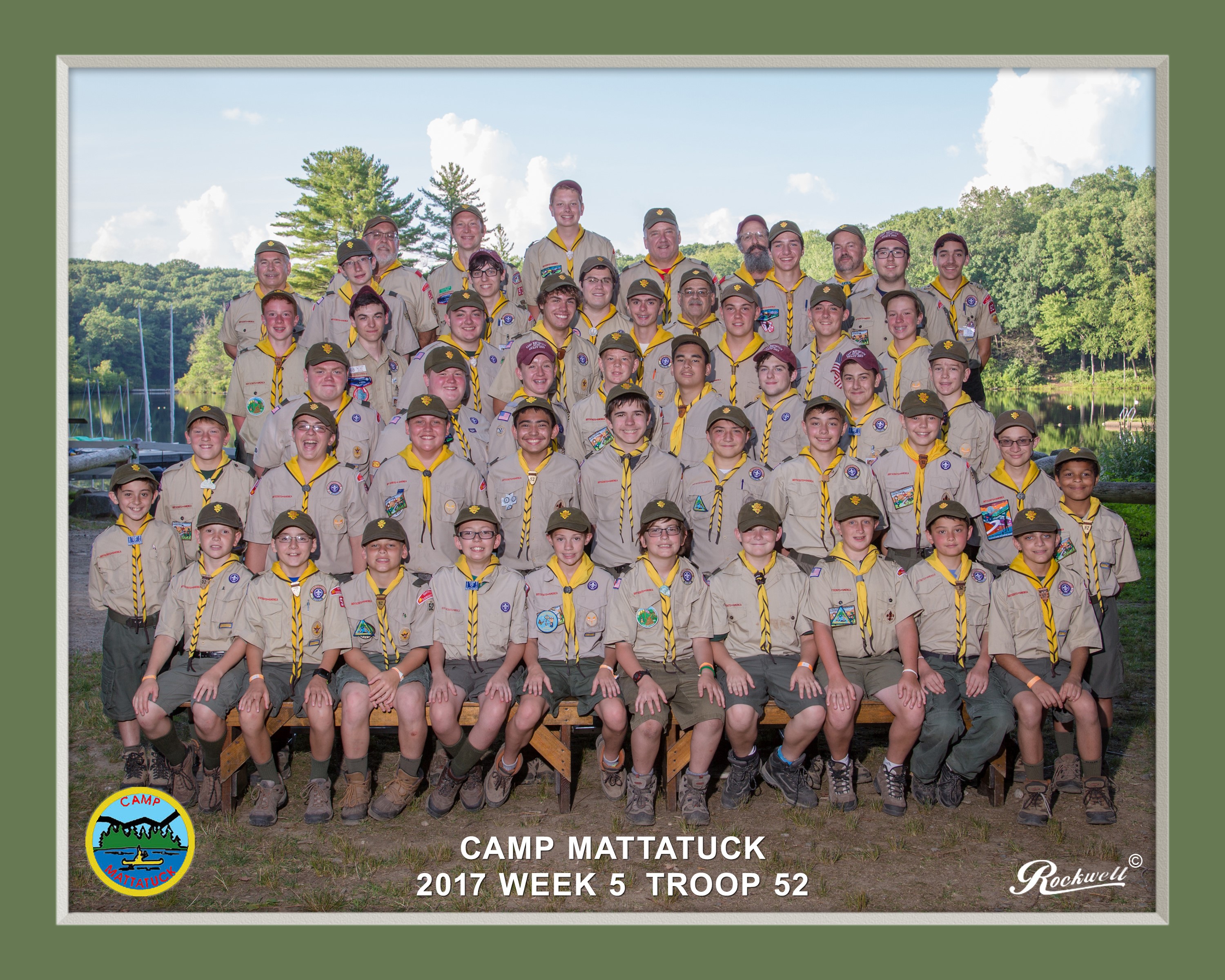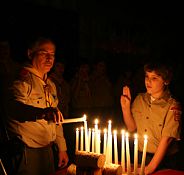|
Links:
Home
About Us
Advancement
Archive
Forms
Games
Links
Parents' Resources
Scoutcraft
Troop Portal
|
First
Class Requirements
- Demonstrate how to find
directions during the day and at
night without using a compass.
- Using a compass, complete an orienteering course that
covers at least one mile and requires measuring the height and/or width
of designated items (tree, tower, canyon, ditch, etc.)
- Since joining, have participated in ten separate
troop/patrol activities (other than troop/patrol meetings), three of
which included camping overnight.
-
- Help plan a patrol menu for one campout that includes
at least one breakfast, one lunch, and one dinner and that requires
cooking at least two meals. Tell how the menu includes the foods
from the food pyramid and meets nutritional needs.
- Using the menu planned in requirement 4a, make a list
showing the cost and food amounts needed to feed three or more boys and
secure the ingredients.
- Tell which pans, utensils, and other gear will be
needed to cook and serve these meals.
- Explain the procedures to follow in the safe handling
and storage of fresh meats, dairy products, eggs, vegetables, and other
perishable food products. Tell how to properly dispose of camp
garbage, cans, plastic containers, and other rubbish.
- On one campout, serve as your patrol's cook.
Supervise your assistant(s) in using a stove or building a cooking
fire. Prepare the breakfast, lunch, and dinner planned in requirement
4a. Lead your patrol in saying grace at the meals and supervise
cleanup.
See below for more
information on Troop 52's Cooking Guidelines
- Visit and discuss with a selected individual
approved by your leader (elected official, judge, attorney, civil
servant, principal, teacher) your constitutional rights and obligations
as a U.S. citizen.
- Identify or show evidence of
at least ten kinds of native
plants found in your community.
-
- Discuss when you should and should not
use lashings
- Demonstrate tying the timber hitch and clove hitch and
their use in square, shear, and diagonal lashings by joining two or
more poles or staves together.
- Use lashing to make a useful camp gadget.
-
- Demonstrate tying the bowline knot and describe several
ways it can be used.
- Demonstrate bandages for a sprained ankle. and for
injuries on the head, the upper arm, and the collarbone.
- Show how to transport by yourself, and with one other
person, a person:
- from a smoke-filled room
- with a sprained ankle, for at least 25 yards.
- Tell the five most common signals of a heart attack.
Explain the steps (procedures) in cardiopulmonary resuscitation (CPR).
-
- Tell what precautions must be taken for a safe trip
afloat.
- Successfully complete the BSA
swimmer test.
- With a helper and a practice victim, show a line rescue
both as tender and rescuer. (The practice victim should be
approximately 30 feet from shore in deep water.)
- Demonstrate scout spirit by living the Scout
Oath (Promise) and Scout Law in your everyday life.
- Tell someone who is eligible to join Boy Scouts,
or an inactive Boy Scout, about your troop's activities. Invite
him to a troop outing, activity, service project or meeting. Tell
him how to join, or encourage the inactive Boy Scout to become active.
- Describe
the three things you should avoid doing related to use of the Internet.
Describe a cyberbully and how you should respond to one.
- Participate in a Scoutmaster conference.
- Complete your board of review.
First Class Cooking Requirement
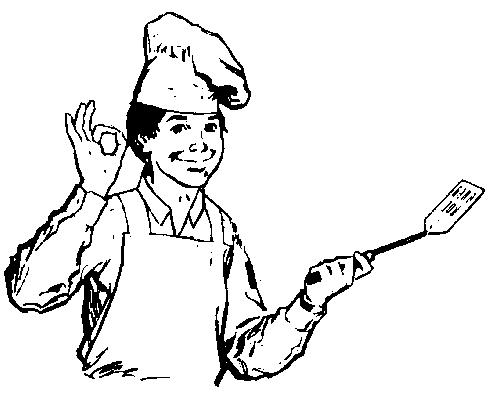
Troop
52 Guidelines for
1st
Class Cooking
1.
You
must be a 2nd Class Scout before starting this requirement.
2.
At
least 3 weeks before a campout get your Patrol Leader's OK to cook one
or two meals. Then let Mr. Tim Martin or
Mr. Brian Turner
know that you want to work on the requirement.
3.
Make
your menu and food shopping list and review it with Mr.Martin or
Mr.Bingham. Write down the plan...what to
do when, like
"wash and cut veggies at home. Start fire
1-1/2 hours before meal. Put meat in a
large fry pan...blah blah blah. Why not
type it on your computer ?
4.
Review
your list and plan with your mom or dad.
5.
Practice
the meal in your kitchen with mom or dad's supervision.
6.
You
will need to work on 2 camping trips to cook the 3 required meals.
7.
Plan
- Prepare - Execute – Evaluate
 More
so now than ever, cooking is
a valuable skill for Scouts to master. In
today’s society men take on more responsibilities
than ever in the
household. Men tend to marry later in
life than in years past. From a Scout
leader’s perspective, cooking is important because it indirectly
requires the
boys to learn another valuable lifelong skill…planning and
preparation. Anyone who is going to be a
successful
outdoor cook has to plan his meals carefully before the trip, prepare
as much
as he can in the comforts of home, then execute his plan skillfully. More
so now than ever, cooking is
a valuable skill for Scouts to master. In
today’s society men take on more responsibilities
than ever in the
household. Men tend to marry later in
life than in years past. From a Scout
leader’s perspective, cooking is important because it indirectly
requires the
boys to learn another valuable lifelong skill…planning and
preparation. Anyone who is going to be a
successful
outdoor cook has to plan his meals carefully before the trip, prepare
as much
as he can in the comforts of home, then execute his plan skillfully.
The young
Scout knows only one way to cook…over a roaring
blaze that scorches the food on the outside and leaves it rare on the
inside. As he gains knowledge and
experience, he learns that there are many styles of cooking, such as
frying,
broiling, stewing, boiling, and baking. Each
requires a different kind of heat. Most
cooking is done over coals, not flame, for an even,
gentle heat
that cooks food thoroughly without burning.
What can
you cook in the outdoors? Anything you can
indoors! But without temperature settings,
you need to
be able to estimate the heat required to cook your meal.
Some meals
are fried on a griddle, others are cooked in a
pot, and many are baked or roasted in a cast iron or aluminum dutch
oven.
Parents
are encouraged to get involved and help their son
practice a meal at home before trying it in the woods.
Even if it’s cooked on the kitchen stove, the
lessons learned with the family will be remembered and applied outdoors. The more opportunities he gets at home will
make him a better cook when he camps.
There are
many ways a Scout can make his job in camp easier
by preparing at home. For instance,
let’s say he’s making a beef stew. Carrots
may be washed, peeled, and cut at home without
harming the
quality of the food. Potatoes can be
scrubbed, but are best left whole so they do not turn brown. Stew beef should be rinsed and cut into bite
sized pieces in your kitchen instead of trying to do it in the woods. Not only does it make camp preparation
easier, you leave the waste at home instead of carrying it to camp.
Wherever
possible, food should be packed in plastic
bags. Leave cardboard and other
excessive packaging home. Your food will
be protected from the weather, your pack will be roomier and lighter,
and
you’ll have less garbage to pack out of the woods.
For many
trips, refrigeration is not necessary because we’re
out in the cold. If camping far from the
car, each patrol has a small collapsible insulated bag to carry
perishables and
ice. Larger coolers are permitted on
trips in warm weather if we are close to the car.
Cleaning
up after a meal is not difficult if the food is
cooked properly and some simple guidelines are followed.
Because of the very limited amount of hot
water available, all plates and pots should be made to look clean
before
touching the wash water. This is best
done by each individual as he finishes his meal. He
can wipe the dish with a piece of bread or
with the soft rubber spatula each patrol should have.
Dishes are washed in hot soapy water, rinsed
in boiling water and allowed to air-dry on a clean piece of plastic
sheeting.
Download Troop
52's Cooking Guidelines
|
|
